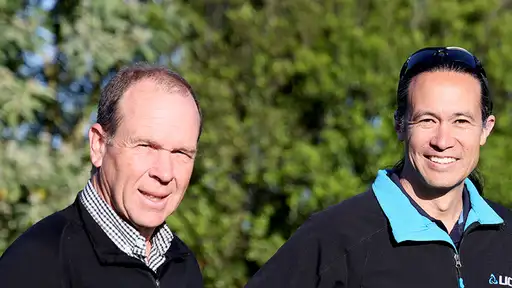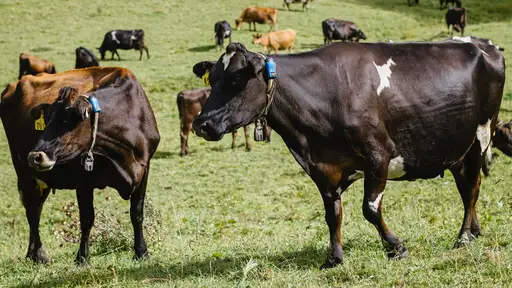Canterbury farmer, Rob Turney, says it was a recent decision to apply a more tactical approach to his mating plan that was key to turbo-charging his two farms’ latest line of replacement calves.
While acknowledging he didn’t necessarily know all aspects of ‘the breeders equation’, Rob says a combination of increased selection pressure within his herd while shortening the generation interval (in his bull team) has provided him with faster rates of genetic gain than previously achieved.
Last year Rob was convinced by his own staff and LIC advice that faster genetic gain could come from upgrading his bull team from the traditional Premier Sires Daughter Proven team of bulls to LIC’s Forward Pack.
And through strategic use of LIC’s Sexed Semen teams, Rob ensured that only the best cows were inseminated for his replacement stock.
“My elder brother is an LIC Technician of about 25 years, and my contract milker at the home farm is a former LIC sales rep… I also have a long association with (LIC territory manager) Garth Stearn, so I have a very good advisory team around me,” Rob said.
“I choose the objective or direction I want for my herd’s genetics, and they simply find a way on how we’re going to get there.”

Access to genomic bulls via Forward Pack had paid immediate dividends for Rob’s latest line of genetics, because use of genomically-selected, young sires was the most-effective way of significantly reducing the generation interval.
However, it was use of Sexed long last liquid (LLL) Semen on the higher-quality cows that had further compounded the gains. For example, in 2021 Rob’s Methven property saw 211 replacement calves born at an average of 210 gBW (genomic breeding worth).
In 2022, on the same property, the 160 newborn replacement calves averaged 287gBW, a 77-point jump (to put this into context, over the previous five years the same farm’s average gBW increase in its annual line of replacements was 19 gBW). It was a simple process of ensuring the best replacements came from the best cows mated to the best bulls, Rob said.
A similar pattern exists at Rob’s home farm near Ashburton. An established, well-known pig farmer, Rob describes himself as a ‘late-comer to dairy farming’.
Therefore, he felt Premier Sires was the best product for his two dairy blocks because he’s able to leave bull selection to the experts'. By experts, Rob means the combined knowledge of key staff that run his farms, together with LIC genetic experts who select the cooperative’s flagship Premier Sires bull teams.
“They’re vastly smarter people than myself, and they drive the mating processes and objectives so I can breed a better, more-ideal, cow. I’m certainly a fan of Premier Sires," Rob said.
“I’m always confident the team has been picked well because it’s an established well-proven method, that has all the great science behind it, and over time, the processes get further refined by LIC.
“They know how to pick and breed good dairy animals, that’s their knitting – semen straws, AB, herd testing, and recording. They’re good at that, and I know they’ve got the people who are interested in it.”

I’m always confident the [bull] team has been picked well because it’s an established well-proven method that has all the great science behind it.
Rob Turney
Garth Stearn, LIC Territory Manager, had recently visited Rob’s farm with local Agri Manager James Agnew: “Using Rob’s own herd performance data, we’ve helped him understand what type of cow best performs in his dairy farming system. While cows often look similar, there are cows and cow groups in the herd, that, from a genetics perspective, perform more profitably.
“These are the cows that we need to identify to become parents of the next generation.”

“So, our aim is to help Rob to see and understand the breeding values that best-link to the desired future direction of his dairy business. It’s no surprise to learn that those desired breeding values are strongly linked to breeding an efficient, profitable, and sustainable dairy herd.”
Herd testing is an essential component to any herd improvement programme, Garth said. Using herd testing data, solid reliability to the production performance of cows could be established, which ensured the breeding indices could be used with confidence in selecting cows.
Over time, calf parentage verification provided confidence that efforts made to breed the best replacements were not lost through inaccurate calf recording, Garth said.
Breeding values provided insight into ancestry, so accurate representation of family attributes was fundamental, he said.
“It’s a great process to go through and connects really well with Rob’s natural instinct to ensure the longer-term view is taken towards future proofing his dairy operation.
“So, Rob asks, how can I get maximum genetic gain, and get ahead faster? This has led to the decision to use the best bulls available in the Forward Pack team, together with Sexed LLL to target the best cows and he underpins this with accurate decision making derived from parentage verification and herd testing.”
Marketing of non-replacement animals provided a real challenge for farmers, and Rob was no exception, Garth said.
“When chatting with Rob some time ago he had access to an export trading market. There was an opportunity to increase the use of Sexed Semen to meet this market potential. One spin-off was accurate parentage using the GeneMark Whole Herd analysis – this ensured he could retain the very best heifers in his business.”
Rob said another closely-related ‘game-changer’ last year was the introduction of collar technology across both his farms, enabling business to go all-AB: “We’ve also put wearables on because I need to future-proof my farm; we realise key staff may eventually move on.
“The wearables have been a success. Out of 620 cows on the home farm we only missed submitting seven cows across six weeks, and you have to remember it wasn’t perfect at the start because we were just getting used to the new ways of doing things.”
Use of Jersey Sexed Semen straws across part of Rob’s Friesian dominant herd was also significant: “I wasn’t sure about the little brown calves in there, because at the end I want a 470kg cow that does 500kgs of milksolids. Traditionally I’ve had an export market for my excess Friesians, so I was curious to see what I could get out of a first-cross.
“But things have worked out pretty well, because it’s been such a wet winter and we haven’t had any calving issues.”
Short gestation dairy genetics were utilised on lower-BW cows, together with cows at the tail-end of mating. “That’s been more about days-in-milk,” Rob says.
“Most of the cows on the two farms are close to 500kg milksolids (per year), so at 2kg of milksolids for an extra 10 days in milk at a payout of say $8, that pays for itself, and it’s dragging cows that are going to mate at week 11 toward calving in 10. There’s lots of good things about SGL.”
Garth said Rob’s approach was a classic case of a desire to get maximum value from a carefully constructed breeding programme: “Fundamentally Rob has great faith in the principles of herd improvement – which is through creating selection pressure on animals, using the best-quality bulls, and ensuring accuracy of recording through parentage, and good, solid herd test information.
“He’s certainly applying well the basic principles of driving rates of genetic gain.”




